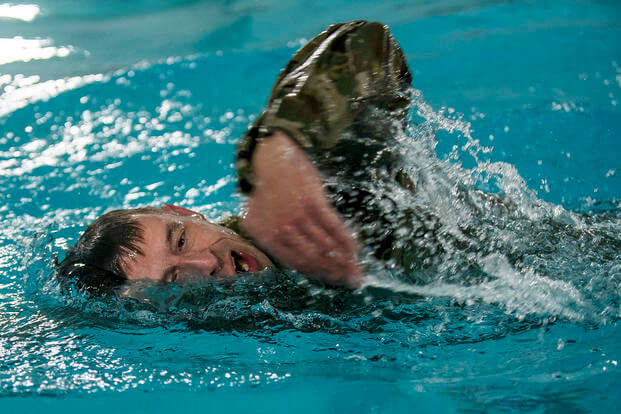Fitness
How This Cardio Fitness Triathlon Builds Leg Speed and Endurance

You will feel this workout even if you only do a third of it. The bike-run-swim, max-effort triathlon can be done individually in under 20 minutes each, or you can double up and make a “BR-ick” out of the workout or do all three and make it a triathlon challenge.
For typical military fitness tests, 1.5-3 miles, these workouts can be placed into the training week once to work on leg speed and endurance. Adding two more types of nonimpact cardio can double or triple the cardio effort and only offer a third of the impact pace. This is a great option for new runners who are susceptible to shin splints and knee tendinitis but must pass a military fitness test quickly. The goal is to move the legs faster than usual (sprint), work the heart and lungs to peak levels quickly and build muscle stamina/endurance in the legs as well.
This workout below has multiple options, including mixing in calisthenics for added leg endurance training:
Warm-up
It is advised to take 5-10 minutes to warm up the lungs and legs, as this first minute of the sets below are full-speed effort events, followed by two minutes of easy recovery time. Whatever event of the three options below you are doing, take 5-10 minutes to warm up with an easy bike, swim or jog and light stretch before going full speed into the workout.
This 1:2 work-to-rest ratio is a more straightforward progression than a 1:1 work-to-rest ratio, but it is ideal for those working to build their endurance and speed in timed runs and swims for standard military fitness tests.
Bike
Starting with the bike warms the legs and prepares them well for the following running event. This bike-run combo will create 40 minutes of cardio with 12 minutes of high-intensity effort. Here is how it works:
Repeat six times.
- Bike one minute fast at moderate resistance levels
- Easy bike for two minutes (easy resistance levels)
Run
Take a short transition from the bike to the run if you do another event with this workout. If you ride the bike first and follow the run, the legs will be a bit wobbly, so shake out the legs with a short jog and stretch before going full speed.
You will find that at full speed for a minute, you feel like you are in a time machine, and a minute will never arrive. It may start like a sprint, but you will struggle to maintain full speed for a full minute at first. Do this workout once a week, and you will see quick improvements in both this workout and your timed run events.
Repeat six times.
- Run one minute fast
- Walk two minutes
Swim
Swimming can be replaced with a third option if you do not need to improve your swimming. Events such as rowing and elliptical machines make good nonimpact cardio options for the third and final set of this cardio workout. It works the same way as above but with whatever you use as your event.
Repeat six times.
- Swim one minute fast
- Leisurely swim or tread for two minutes
After trying this 18-minute workout, you will find that you need to have some carbohydrates available or have eaten something before the workout. Though it is only an 18-minute section of a workout, it will quickly drain you of glycogen and blood sugar because of the high intensity of effort needed to run, bike or swim this fast for a minute.
Add this once a week to your four- to six-week training and notice the improvements in your breathing and recovery when running or swimming if you also take swimming fitness tests. We started doing this at the beginning of the summer (six weeks) and have seen several people improve their run times from more than 10 minutes for 1.5 miles to sub-nine minutes in that time.
Want to Learn More About Military Life?
Whether you’re thinking of joining the military, looking for fitness and basic training tips, or keeping up with military life and benefits, Military.com has you covered. Subscribe to Military.com to have military news, updates and resources delivered directly to your inbox.

/static.texastribune.org/media/files/f5fdb1dff4d6fd788cba66ebaefe08d0/Paxton_GOP_Convention_2018_BD_TT.jpg)






